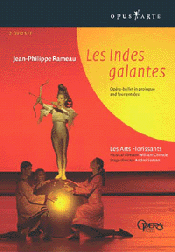These qualities are abundant his operas, which transcend stereotypes of static opera seria through their descriptive orchestral writing, their lyrical airs, and a style of recitative that follows the natural flow and music of the French language, without devolving into dry recitation.
Rameau was 50 when his first opéra tragique (tragic opera), Hippolyte et Aricie, debuted on the stage of the Académie Royale de Musique in 1733. With this work, Rameau was treading on familiar operatic ground, but many in the audience were baffled by Rameau’s daring realization of opéra tragique, a genre established by the still-beloved Lully (1632-1687). Les Indes galantes (1735) belongs to a different operatic genre, the opéra-ballet, which featured independent—but loosely connected—plots separated into several entrées. As the genre’s name suggests, dance played an important part in the opéra-ballet, and Les Indes galantes is no exception; each entrée closes with a divertissement, a collection of dance movements and dance songs that tie into the plot of the entrée.
At its premiere in 1735, Les Indes galantes consisted of a prologue and three entrées: “Le Turc généreux” (The Generous Turk), “Les Incas du Pérou” (The Incas of Peru), and “Les Fleurs” (The Flowers); soon after the premiere, Rameau added a fourth entrée, “Les Sauvages” (The Savages). Each entrée is set in a different exotic location—Turkey, Peru, Persia, and America. The librettist, Louis Fuzelier, indicated the sources of inspiration for these locales in his published preface to the libretto: The plot of “Le Turc généreux” was inspired by a news report in the journal Mercure de France, while both “Les Incas du Pérou” and “Les Fleurs” reflect popular contemporary travel literature. The source of the setting of “Les Sauvages” is a 1725 visit to Paris by two native Americans from France’s new colony in Louisiana; Rameau’s set of harpsichord pieces entitled Les Sauvages were inspired by the dances performed by the two visitors, and served as the basis for the divertissement of the final entrée of Les Indes galantes. The entrées are strung loosely together by a common thread introduced in the Prologue, in which the Hébé, the goddess of youth, laments the seduction of idle youths by Bellone, the goddess of war, who promises them glory in battle. Hébé calls on Cupid to send his winged followers throughout the world to search for true love.
The musical performances in this production are superb—everything that one can expect from Les Arts Florissants and its director, William Christie. The soloists all have clear, agile voices, and are accomplished actors. In particular, the air “Viens, hymen, viens m’unir au vainqueur que j’adore” (Come, Hymen, to unite me with the conqueror whom I love) in “Les Incas du Pérou” and the quartet “Tendre amour, que pour nous ta chaîne” (Tender love, may you enchain us) are meltingly lovely.
On the other hand, the staging by Andrei Serban is uneven. Certainly the genre of opéra-ballet is lighter than opéra tragique, but the director seems determined to find humor everywhere, from a “goddess” of war in drag, to a slinky Indian maiden singing of the “innocence” of love. To my mind, only the mistaken identity in the plot of the Persian entrée (“Les Fleurs”) is clearly humorous, as it foreshadows comic theatrical devices that came to fruition in Mozart’s Cosi fan tutte. The director’s stated goal was to provide an imaginative feast for the eyes, but the quest for visual brilliance and comedy often threatens to descend into meaningless antics. Serban does not seem comfortable with letting the music carry the action; a number of gentle airs are overshadowed by stage business that seems to have no purpose, from a simple procession of people in the background, to a recurring acrobatic act that culminates in the pair dangling from the fly space à la Cirque du Soliel. The use of supernumeraries in large head-masks was probably meant to be whimsical, but to me the human minarets populating “Le turc généreux,” the dancers wearing huge flower pots in “Les Fleurs,” and the life-size Hopi Kachina dolls cavorting in “Les Sauvages” were just silly.
Because of the large amount of music for dance in the opéra-ballet, the choreographer plays an important role in the staging, but Blanca Li is as inconsistent as the director. In the prologue, the dancers’ steps are clearly based on authentic Baroque dance, but the choreographer has inserted odd body and arm positions that come straight out of modern classical dance. Although most of the dance seems in the style of Martha Graham, we see sailors executing moves from On the Town in “Le turc généroux” and flower pots dancing the Charleston and the “Swim” in “Les Fleurs.” On the whole, the director does not seem to give Rameau enough credit to be able to hold the audience through the music, but feels compelled to keep his audience visually entertained instead.
Deborah Kauffman
Editor, Journal of Musicological Research
University of Northern Colorado
